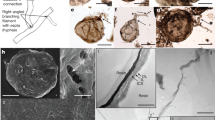Abstract
During the last two decades the occurrence of microbial fossils in silicified Precambrian rocks has become firmly established. The significance of these early microorganisms in the bio-geo-chemical evolution has been recognized, and their frequent affiliation with. stromatolitic structures, common in Precambrian strata, has been documented (Reviewed by Schopf, 1970b; Licari and Cloud, 1972). A large number of Precambrian fossil microorganisms has been formally described (pflug, 1965, 1966; Schopf, 1968; Schopf and Blacic, 1971). Based on these descriptions and identifications oftaxonomic affmities of Precambrian microorganisms, dates have been proposed for important early evolutionary events, such as photosynthesis (Schopf et al., 1971), N2 -fixation (Cloud, 1974), Eukaryotic cell organization (Schopf, 1968, 1970b; Cloud et al., 1969) and sex (Schopf and Blacic, 1971). However, the criteria used in identification offossil microorganisms remain in many cases dubious, leaving the already generally accepted conclusions on shaky grounds..
Access this chapter
Tax calculation will be finalised at checkout
Purchases are for personal use only
Preview
Unable to display preview. Download preview PDF.
Similar content being viewed by others
Bibliography
Awramik, S.M., Golubic, S., Barghoorn, E.S.: Blue-green algal cell degradation and its implication for the fossil record. Geol. Soc. Am., Abstr. Programs 4 (7), 438 (1972).
Barghoorn, E.S., Tyler, S.A.: Microorganisms from the Gunflint chert. Science, N.Y.147, 563-577 (1965).
Cloud, P.E. Jr.: Evolution of ecosystems. Am. Scientist 62, 54-66 (1974).
Cloud, P.E. Jr., Hagen, H.: Electron microscopy of the Gunflint microflora: preliminary results. Proc. Natl. Acad. Sci. US 54, 1-6 (1965).
Cloud, P.E. Jr., Licari, G.R.: Ultrastructure and geologic relations of some two-aeon old nostocacean algae from northeastern Minnesota. Am. J. Sci. 272, 138-149 (1972).
Cloud, P.E. Jr., Licari, G.R., Wright, L.A., Troxel, B.W.: Proterozoic eucaryotes from eastern California. Proc. Natl. Acad. Sci. US 62, 623-631 (1969).
De Castro, P.: Osservazioni su Aeolisaccus kotori Radoicic, 1959 (Cyanoschizophyta). Boll. Soc. Natur. in Napoli 84, 1-44 (1975).
Golubić, S.: The relationship between blue-green algae and carbonate deposits. In: The Biology of Blue-green Algae. Carr, N.G., Whitton, B.A. (eds.). Oxford—London—Edinburgh—Melbourne: Blackwell Scientific Publications, 1973, pp. 434-472.
Golubić, S.: Organisms that build stromatolites. In: Stromatolites. Walter, M.R. (ed.). Amsterdam: Elsevier Publ. Co., 1976a, pp. 113-129.
Golubic, S.: Taxonomy of ,extant stromatolite-building cyanophytes. In: Stromatolites. Walter, M.R. (ed.). Amsterdam: Elsevier Publ. Co., 1976b, pp. 127-140.
Golubic, S., Hofmann, H.J.: Comparison of Holocene and mid-Precambrian Entophysalidaceae (Cyanophyta) in stromatolitic algal mats: cell division and degradation. J. Paleontol. 50, 1074-1082 (1976).
Hofmann, H.J.: Mid-Precambrian prokaryotes (?) from the Belcher Islands, Canada. Nature 249, 87-88 (1974).
Hofmann, H.J.: Precambrian microflora, Belcher Islands, Canada: significance and systematics. J. Paleontol. 50, 1040-1074 (1976).
Kazmierczak, J.: Colonial Volvoca1es (Chlorophyta) from the Upper Devonian of Poland and their palaeoenvironmental significance. Acta Palaeont. Pol. 20, 73-85 (1975).
Knoll, A.H., Barghoorn, E.S.: Precambrian eukaryotic organisms: a reassesment of the evidence. Science, N.Y. 190,52-54 (1975).
Knoll, A.H., Barghoorn, E.S., Golubic, S.: Palaeopleurocapsa wopfnerii gen. et sp. nov.: A late Precambrian alga and its'modern counterpart. Proc. Natl. Acad. Sci. US 72, 2488-2492 (1975).
Licari, G.R., Cloud, P.E. Jr.: Prokaryotic algae associated with Australian Protorozoic stromatolites. Proc. Nat1. Acad. Sci. US 69, 2500-2504 (1972).
Oehler, D.Z.: Transmission electron microscopy of organic microfossils from the late Precambrian Bitter Springs Formation of Australia: Techniques and survey of preserved ultrastructure. J. Pa1eontol. 50,90-106 (1976).
Oehler, D.Z.. Pyrenoid-like structures in late Precambrian algae from the Bitter Springs Formation of Australia. J. Paleonto1., in press.
Pflug, H.D.: Organische Reste aus der Be1t-Serie (Algonkium) von Nordamerika. Paliionto1. Z. 39, 10-25 (1965).
Pflug, H.D.: Einige Reste niederer Pflanzen aus dem A1gonkium. Pa1aeontographica 117 B, 59-74 (1966).
Pflug, H.D.: Structured organic remains from the Fig Tree Series (Precambrian) of the Barberton Mountain Land (South Africa). Rev. Palaeobot. Palynol. 5,9-29 (1967).
Schopf, J.W.: Microflora of the Bitter Springs Formation, Late Precambrian, Central Australia. J. Paleonto1. 42, 651-688 (1968).
Schopf, J.W.: Electron microscopy of organically preserved Precambrian microorganisms. J. Paleonto1. 44, 1-6 (1970a).
Schopf, J.W.: Precambrian micro-organisms and evolutionary events prior to the origin of vascular plants. BioI. Rev. 45, 319-352 (1970b).
Schopf, J.W., Blacic, J.M.: New microorganisms from the Bitter Springs Formation (Late Precambrian) of the North-Central Amadeus Basin, Australia. J. Paleonto1. 45, 925-960 (1971).
Schopf, J.W., Oehler, D.Z., Horodyski, J., Kvenvolden, K.A.: Biogenicity and significance of the oldest-known stromatolites. J. Paleontol. 45, 477-485 (1971).
Sorensen, L.O., Conover, J.T.: Algal mat communities of Lyngbya confervoides (C. Agardh) Gomont. Inst. Mar. Sci. Univ. Texas, Publ. 8, 237-249 (1962).
Thompson, D.W.: On Growth and Form. 793 pp. Cambridge: Univ. Press 1917.
Walsby, A.E.: The extracellular products of Anabaena cylindrica Lem. I. Isolation of a macromolecular pigment-peptide complex and other components. Brit. Phycol. J. 9, 371-381 (1974).
Author information
Authors and Affiliations
Editor information
Editors and Affiliations
Rights and permissions
Copyright information
© 1977 Springer-Verlag Berlin · Heidelberg
About this paper
Cite this paper
Golubić, S., Barghoorn, E.S. (1977). Interpretation of Microbial Fossils with Special Reference to the Precambrian. In: Flügel, E. (eds) Fossil Algae. Springer, Berlin, Heidelberg. https://doi.org/10.1007/978-3-642-66516-5_1
Download citation
DOI: https://doi.org/10.1007/978-3-642-66516-5_1
Publisher Name: Springer, Berlin, Heidelberg
Print ISBN: 978-3-642-66518-9
Online ISBN: 978-3-642-66516-5
eBook Packages: Springer Book Archive




